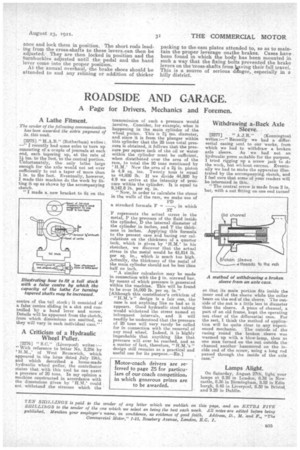ROADSIDE AND GARAGE.
Page 31

If you've noticed an error in this article please click here to report it so we can fix it.
A Page for Drivers, Mechanics and Foremen.
A Lathe Fitment.
The sender of the following communication has been awarded the extra payment of 5s. this week.
[2275] " H.A.B." (Rotherham) writes : —" I recently had some axles to turn up censisting of a couple of journals at each end, each tapering up, at the rate of
ins, to the foot, to the central portion. Unfortunately, the only lathe large enough for the axle would not set over sufficiently to cut a taper of more than 1 in, to the foot. Eventually, however, I made this machine do the work by fitting it up as shown by the accompanying sketch.
"I made a new bracket to fit on the centre of the tail stock ; it consisted of a false centre sliding in a slot and controlled by a hand lever and screw. Details will be apparent from the sketch, from which dimensions are omitted, as they will vary in each individual ease."
A Criticism of a Hydraulic Wheel Puller.
[2276] " S.C." (Liverpool) writes :— " With reference to letter No. 2,256 by of West Bromwich, which appeared in the issue dated July 19th, and which described a home-made hydraulic wheel puller, the contributor states that with this tool he can exert a pressure of 20 tons. In my opinion a machine constructed in accordance with the dimensions given by 11.31.' could not withstand the stresses which the
transmission of such a pressure would involve. Consider, for example, what is happening in the main cylinder of the wheel puller. This is 21 ins, diameter, and since it is from the plunger within this cylinder that the 20 tons total pressure is obtained, it follows that the pressure per square inch of the oil or water within the Cylinder must be sufficient, when distributed over the area of the ram, to total the 20 tons mentioned by `H.1)1.' Now the area of a 2i in. piston is 4.9 sq. ins. Twenty tons is equal to 44,800 lb. If we divide 44,800 by 4.9 we arrive at the intensity of pressure within the cylinder. It is equal to 9,142.8 lb. per sq. in. "Now, in order to calculate the stress in the walls of the ram, we make use of PD a standard formula F = —, in which 2T
F represents the actual stress in the metal, P the pressure of the fluid inside the cylinder, D the internal diameter of the cylinder in inches, and T the thickness in inches. Applying this formula to the present case and basing our calculations on the thickness of a quarter inch, which is given by '11.M.' in his sketches, we discover that the actual stress in the metal would be 45,814 lb, per sq. in., which is much too high. Actually, the thickness of the metal of the main cylinder should not be less than half an inch.
"A similar calculation may be made in connection with the in. screwed bar, by means of which pressure is generated within the machine. This will be found to be over 16,000 lb. per sq. in." [Although this contributor's criticism of design is a fair one, the case is not anything like so bad as it appears. Good hydraulic steel tubing would withstand the stress named at infrequent intervals, and it will readily be understood that the pressure of 20 tons will very rarely be called for in connection with the removal of any road wheel, Indeed, it is highly improbable that anything like that pressure will ever be reached, and as a matter of fact, therefore, " " design still remains as a practical and useful one for its purpose.—En.]
Withdrawing a,Back Axle Sleeve.
[22771 " A.J.R." (Kennington) writes :—" Recently we had a differential casing sent to our works, from which we had to withdraw a broken axle sleeye. As we had not an hydraulic press suitable for the purpose, I tried rigging up a screw jack to do the work, but without success. Eventually we had to make the apparatus illustrated by the accompanying, sketch, and I feel sure that some of your readers will be interested in this.
" The central screw is made from 2 in_ bar, with a nut fitting on one end turned so that its main portion fits inside the inner end of the sleeve while the collar bears on the end of the sleeve. The outside of the nut is a little less in diameter than the sleeve. A piece of channel, a part of an old frame, kept the operating nut clear of the differential case. For the rest, I think the method of application will be quite clear to any experienced mechanic. The outside of the casing round the broken sleeve was warmed up with a blow-lamp, then as one man turned on the nut outside the channel another hammered on the inside end of the screw, using a long rod passed through the inside of the axle case."
Lamps Alight.
On Saturday, August 27th, light your lamps at 8.28 in London, 8.32 in Newcastle, 8.36 in Birmingham' 8.52 in Edin burgh, 8_45 in Liverpool, 8.38 in Bristol and 9.28 in Dublin.
































